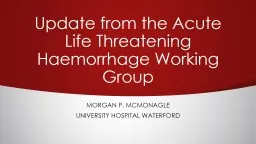

Morgan P McMonagle University Hospital Waterford Four Broad Areas Why Do Trauma Patients Die Major Trauma Outcome Study ACS COT 3040 of early trauma deaths are directly attributable to haemorrhage ID: 934395
Download Presentation The PPT/PDF document "Update from the Acute Life Threatening H..." is the property of its rightful owner. Permission is granted to download and print the materials on this web site for personal, non-commercial use only, and to display it on your personal computer provided you do not modify the materials and that you retain all copyright notices contained in the materials. By downloading content from our website, you accept the terms of this agreement.
Slide1
Update from the Acute Life Threatening Haemorrhage Working Group
Morgan P. McMonagle
University Hospital Waterford
Slide2Four Broad Areas
Slide3Why Do Trauma Patients Die?Major Trauma Outcome Study (ACS COT):30-40% of early trauma deaths are directly attributable to haemorrhageIt is estimated that 62% of all in-hospital trauma deaths occur within the first four hours, of which
haemorrhage is either the primary cause or a major contributing factorMajor haemorrhage is probably the most important remediable contributor to both mortality and morbidity in the trauma patientEarly haemorrhage control, whether it occurs naturally or after iatrogenic intervention such as embolisation or intraoperatively by a surgeon, is paramount in achieving good patient outcomesEffective and timely haemorrhage recognition and control may be the single most important step in the emergency management of the severely injured patientEur J Trauma Emergency Surg 2013:39:375-383
Slide4Exsanguinating Haemorrhage Definition / recognitionPre-emptiveSite of the most compelling source of bleedingPre-hospital & ED (pre-operative) techniquesHypotensive resuscitationOperative techniquesResuscitationFluidsBloodBlood productsAdjuncts
Slide5Management
Slide6Damage control at seaCapacity of ship to absorb damage
& maintain mission integrity
Slide7Damage control in trauma
Slide8ACIDOSIS
HYPOTHERMIA
COAGULOPATHYTRAUMA TRIAD OF DEATHHAEMORRAGEFLUID ADMINISTRATIONOPERATIVE EXPOSURELOSSBLOOD LOSSTissue PerfusionClotting factorsO2 Carrying capacityIntravascular ColloidsTRAUMA
Slide9ACIDOSIS
HYPOTHERMIA
COAGULOPATHYTRAUMA TRIAD OF DEATHHAEMORRAGEFLUID ADMINISTRATIONOPERATIVE EXPOSURELOSSBLOOD LOSSTissue PerfusionClotting factorsO2 Carrying capacityIntravascular ColloidsTRAUMA
Slide10Damage Control
EventTime
PrehospitalEDALS
OR
ICU
Control bleeding
• bleeding
• contamination
Pack
OR
ICU
Planned reoperation
• reconstruction
• repair
Slide11Damage control pathwayTempo
Synchronization
Slide12DAMAGE CONTROL: An approach for improved survival in exsanguinating penetrating abdominal injuryControl hemorrhageControl contaminationIntraabdominal packingTemporary closure
Core rewarmingCorrect coagulopathyMaximize hemodynamicsVentilatory supportPART I - ORPART II - ICU Pack removal Definitive repairs
PART III - ORRotondo, Schwab et al J Tra 1993
….standard lap vs Dam Control: 11 vs 77% survival
Slide13Damage Control: HOW?Rapid transport (EMS)Decision ----> ORResuscitation (TB)
O2, Blood, Prevent heat loss Massive transfusion protocolRewarmingCorrect coagulopathyMaximize hemodynamicsVentilatory supportRe-examDC0 “Ground zero” - RecognitionDC II - ICU Pack removal Definitive repairs Closure ? Control hemorrhage
Control contamination Intraabdominal packing TACDC I – OR (warmed)Johnson, Gracias, Schwab, et al. JTrauma 2001.DC III - ORDC IV - OR Definitive ClosureMinutes
< 2 hrs
~24-36 hrs
48hrs –1yr
Slide14Permissive hypotension
Slide15Slide16Slide17Among blunt trauma patients, 24-hour mortality was 3% (CR) and 18% (SR); adjusted odds ratio of 0.17 (0.03-0.92)
Slide18DCR
Limited crystalloid
Permissive hypotension Balanced resuscitationWhole Blood
Viscoelastic
testing
Massive Transfusion Protocols
Hemostatic adjuncts
Slide19Massive Transfusion Protocolization
What is Exsanguinating Haemorrhage?
Slide20Massive transfusion protocol
Limit crystalloid
Resuscitate with blood products1:1:1 PRBCs:FFP:PlateletsCryoprecipitateConsider pro-coagulantsTranexamic acid
Slide21Brohi, J Trauma 2003; 54:1127-30Coagulopathy & Mortality
Gonzalez E. J Trauma 2007; 62:112
Slide222007; 62:112
Kashuk, J. J Trauma 2008; 65 : 261
Slide23Slide24Slide25Slide26Slide27Slide28Slide29Mortality by Plasma : RBC Ration = 252
The ratio of blood products transfused affects mortality in patients receiving massive transfusions at a combat support hospital. Borgman MA, et. submitted, J Trauma, 2007.P < 0.05
Slide30Tranexamic acid
Slide31Damage Control Resuscitation (DCR)
Modern term where best outcomes practice in the severely injured or major haemorrhaging patient, starting in the pre-hospital environment and continuing right through Emergency Department arrival and immediately on to Stages I and II. DCR takes in to account;Blood loss volumeInjury burdenPatient physiologyThe approach in DCR may be considered unorthodox to traditional surgical dogma including;Minimal fluid resuscitationRapid transportation to a Major Trauma Centre1:1:1 transfusion ratiosHypotensive resuscitationEarly and aggressive haemorrhage controlDamage control surgery (abbreviated to <90mins)TourniquetsVascular shunting & ligationAbdominal packing Pelvic packing & binderContamination controlICU correction of the Trauma TriadAcidosisCoagulopathyHypothermia
Slide32Damage control pitfallsSlide33How it Differs…
Slide34Thank you!